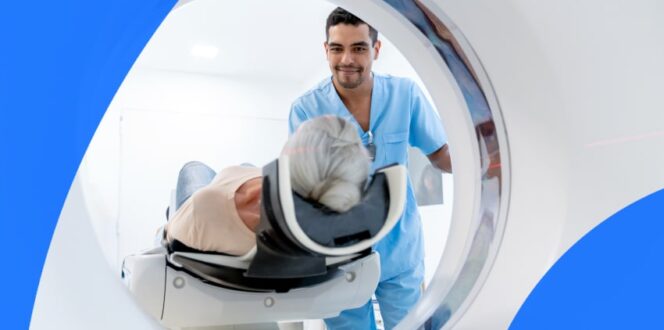How to Read a Radiology Report According to a Radiologist

Not sure how to read your most recent radiology report? A radiologist provides a full breakdown of how to interpret imaging reports.
Radiology reports are written by a radiologist for your referring physician and follow a typical format that contains procedure notes and findings. These reports contain complex medical terminology, which can make reviewing your radiology report feel daunting, especially if you don’t have a medical background.
Dr. Bonnie O’Hayon, Radiologist at North York General Hospital and Adjunct Lecturer at the University of Toronto, explains the ins and outs of standard radiology reports in this insider’s guide to reading your imaging report.
This article outlines each section of a standard radiology report so you can better understand your test results. Accessing your radiology report before your follow-up appointment allows you to feel more confident asking informed questions and following along as your referring provider reviews your results.
With PocketHealth, you can access your images and reports as soon as they’re released by the hospital, patient portal or imaging clinic, allowing you to review your results before speaking with your physician. Access your records here.
Breaking down the sections in your radiology report
Once you’ve had your imaging exam, the interpreting radiologist will closely review your images and prepare a report for your referring physician. Your physician will then discuss the report findings with you at your follow-up appointment.
Type of exam
Your radiology report will indicate the type of exam you’ve had based on the imaging modality used. There are 4 main types of imaging modalities: X-ray, ultrasound, MRI scan and computed tomography (CT) scan. You will see which imaging study or exam you’ve had listed at the top of your imaging procedure report.
Comparison
Your report may list previous exams so that the radiologist can compare your past imaging results to your current results. Comparing imaging reports allows the radiologist to use your medical history and previous exams to create a more comprehensive report.
Clinical information
Your doctor or healthcare provider will give the radiologist all relevant information about your case and it will be listed in the clinical information section of your report, as well as the reason the imaging examination was requested. This section may also be called Clinical Indication, explaining any important details like clinical symptoms or past diagnoses to guide the radiologist in their assessment.
Reviewing the Clinical Information section of your report lets you make sure your doctor has communicated your symptoms correctly so that the radiologist can create an informed report.
It’s important to go over this information because the history your doctor supplies in your referral might change the radiologist’s explanation for what they find on your test.
For example, Dr. O’Hayon notes, “When the history is ‘Right lower quadrant pain and bloody diarrhea two days after a trip to the Dominican Republic’. Something like Crohn’s disease or travelers’ diarrhea may have a similar appearance on a scan, but the clinical history is extremely helpful to make an appropriate diagnosis.”
Although a diagnosis can sometimes be clear without any clinical history, a lack of relevant clinical information can make it harder for the radiologist to provide a relevant report.
Technique
This section of your report gives detailed information about how your imaging procedure was conducted. For example, if you received a contrast dye injection for an MRI or CT scan, it will be listed here.
The Technique section is particularly helpful when reviewing prior reports because it indicates how past exams were conducted so the radiologist can follow the same imaging technique for your current procedure. Consistent imaging exam procedure through multiple exams lets your test results be easily compared against each other.
Findings
This is where you can find most of the information from your imaging exam. It’s usually the longest part of your report and includes the majority of the details from your radiologist’s notes. Here, your doctor will review the information the radiologist summarizes and communicate it to you at your follow-up appointment.
You may see the term “unremarkable” throughout this section of your report. “As humans, we’re imperfect, but some imperfections are not always relevant to our health, so the radiologist will not focus on these insignificant findings,” says Dr. O’Hayon. “Take a small benign cyst in a kidney, for example. Having one or two small, benign-looking cysts in our kidneys is an extremely frequent finding on an abdominal ultrasound in a middle-aged patient and the incidence only increases with age, kind of like freckles that appear on our skin or gray hairs we acquire on our head,” notes Dr. O’Hayon. “At the conclusion of the report, your kidney may be categorized as ‘unremarkable’ instead of ‘normal’, signaling that while technically not 100% ‘normal’, there’s nothing significant going on that requires extra attention or investigation.”
The Findings section of your report also contains information about the internal structures of your body that may have been captured on the scan but are not the focus of the scan. For example, even if you’ve reported abdominal pain and your doctor is concerned about your bowels, the radiologist will still look at all the organs captured on the abdominal imaging scan, including the blood vessels in the area and the bony structures.
Impression
The Impression section is the most important part of your report. Here, the radiologist summarizes their impression of the details of your scan and may contain a potential diagnosis.
“This is where you should find the most meaningful information in your report,” Dr. O’Hayon explains. The radiologist has reviewed your findings and synthesized all that data to come up with a conclusion…essentially his or her opinion about what your test shows.”
In the Impression section, you may see the term “unremarkable” again, as well as the term “differential diagnosis”. “Differential diagnosis means there is more than one potential diagnosis to explain the radiologist’s findings”, Dr. O’Hayon adds. “Generally, the radiologist will list the potential diagnoses in order of likelihood; in other words, the first thing on the differential diagnosis list is most likely, and the last is least likely. Occasionally the last condition on the list can be very unlikely, but it’s included for completeness.”
The Impression section of your report may contain confusing medical jargon. Referencing the relevant information in the Findings section can help, but you can use PocketHealth Report Reader to help make sense of what you see. Keep in mind, though, that you’ll need to speak with your doctor for a thorough review of your report and a complete diagnosis.
How to get access to your radiology reports
Waiting for your referring physician to schedule a follow-up appointment to discuss your results can be nerve-wracking, but you may not have to wait as long as you think. With PocketHealth you can quickly and easily gain online access to your images and results as soon as they are released by the hospital imaging department or imaging clinic, often before you’re follow-up appointment with your doctor.
You can also securely store and share your test results directly from your device, making it easy to get a second opinion. Access your records here.
How PocketHealth can help you better understand your results
Radiology reports can be complicated and you will likely encounter complex medical terminology in your report. Report Reader provides clear definitions for the medical terms in your report, giving you an insider’s guide to reviewing your findings.
You can go one step further in preparing for your next steps with PocketHealth MyCare Navigator. MyCare Navigator lets you know when a follow-up is needed and gives you valuable insights into your health by suggesting personalized follow-up questions for your doctor. MyCare Navigator also gives you access to preventative screening tools, helping you stay on top of your next steps and take charge of your healthcare journey.
Be your own health advocate
Understanding your imaging report puts you in a place of confidence. Knowing what to expect in each section of your report can take some of the guesswork out of understanding your results, helping you feel more prepared for any next steps.
By using PocketHealth to securely access your imaging results, you can prepare questions ahead of your follow-up appointment, so you feel informed and confident talking with your doctor.
How PocketHealth works
Learn how to use PocketHealth to securely access, better understand and share your radiology report results.
Published: December 13, 2022
Trusted by more than 800+ hospitals and clinics.



















